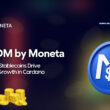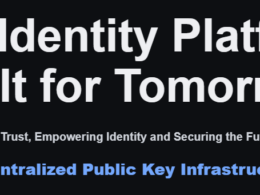In this article I will explain Blocktrust, the development that provides identity tools on the Cardano blockchain.
I have written several articles on decentralized identity. At the end I leave some of them that I consider may be useful to better understand this concept.
Blocktrust is based on the technology of Atala PRISM, which is a Self-Sovereign Identity (SSI) platform and set of services for verifiable data and digital identity developed by IOG, the founding company and developer of the Cardano blockchain. Atala PRISM offers a basic infrastructure for the issuance of DId (Decentralized Identifiers) and verifiable credentials.
Blocktrust integrates SSI solutions, for login, for KYC purposes, for DAO rights management, among other use cases integrated into the Atala PRISM technology stack.
This development has several applications. Let’s see.
Identity Wallet
Blocktrust currently offers a wallet with browser extension for Atala PRISM.
The browser extension wallet manages, issues and shares credentials from the browser, to enable interaction with websites.
Additionally, the wallet supports secure chat functionalities and can interact with embedded websites to sign and authenticate with a DId signing key.
With this wallet you can manage your DId and credentials in one place,issue, receive and revoke credentials, verify credentials, connect to PRISM-compatible websites, and always maintain encryption.
The team plans to expand the wallet’s features, including improved backup/restore options, support for other DId methods, integration with Cardano crypto wallets, and specialized workflows for specific use cases.
Analytics Platform
This platform satisfies the need to understand how the network is growing, who is using it, and how it is being used.
But in particular it proposes to understand chains of trust. How is trust spread? How do you build trust from the bottom up?
The tool is divided into three main sections:
- the statistical summary, with ready-made live generated reports, to get an overview of the actual use of PRISM
- an area of analysis to get to the bottom of certain specific issues that are relevant to individual users, companies, developers. For example how many credentials were issued by this DId, or how many DIds associated with this DId show compromise in the last 30 days
- a graph view to perform targeted analysis and investigate trust chains in complex networks.
Credential Builder
DIds can be created, connected to wallets, and issued Verifiable Credentials using the Blocktrust Credential Builder.
The Credential Builder is a user interface built on a PRISM agent, which can be hosted by Input Output Global or executed on your own system.
Instead of using the REST endpoint to perform common actions, you can take advantage of the Credential Builder user interface, which allows direct configuration of multiple agents side by side and facilitates common SSI interaction patterns, such as issuance of credentials from one agent to another.
The user interface is a single page application that runs exclusively in the browser, without any backend. This setup allows users to enter their API keys into the interface without risk of leakage. The application communicates with the corresponding agent endpoints using the current API definition.
Basic functionalities include the creation of local DIds on the agent, as well as the publication of DIds on the blockchain, although at the moment only applicable for agents hosted on IOG servers.
DIComm Mediator
Blocktrust Mediator is your trusted partner in DIdComm v2 messaging, simplifying secure communication and digital identity management.
As a personal digital post office, it securely transfers a variety of data types, using decentralized identifiers for added security.
Created as an open source tool integrated with the .NET ecosystem, this application paves the way for the next era of secure messaging by facilitating the secure transmission of various types of data directly from one wallet to another, from simple text messages, and files, to verifiable credentials.
The technology mirrors the utility of an email server, but takes security to another level by leveraging decentralized identifiers.
Web Credentials
When we think about SSI, we first think about privacy, about autonomous control over one’s credentials, but this is only part of the equation.
To determine whether websites, service providers, or projects of any kind can be trusted, review systems, trust badges, or simply search ranking on a search engine’s results page are used in the Web 2.0 world.
However, often these signs of trust are manipulated, paid for, and fabricated by fake reviewers.
Web 3.0 offers the possibility for statements made by companies or people to each other to be cryptographically verifiable. Thus, trusted entities that have a hard-earned reputation, for example domain experts, can delegate trust to others, endorsing their work.
Many types of credentials don’t become truly powerful until they are publicly accessible.
This application tries to make these credentials visible, using a set of tools to embed credentials in web pages and make them verifiable for third parties with just one click.
Technically, the project is based on Atala PRISM and usesDId to identify both the identity of the person making the declaration (Issuer) and that of the recipient of the declaration (Owner). The statement itself is called a Verified Credential and could simply be a short note, a long review or an image, logo or badge.
The core of the project consists of a web service that periodically checks the validity of statements that have already been published, and provides a customizable JavaScript snippet to display the given statement on a website or online store.
Workflow Platform
This application is a no-code solution designed to optimize SSI workflows for developers, enterprises and innovators, built on the .NET framework and coded in C#, Blocktrust.
It proposes an intuitive and easy-to-use interface, with configuration and modification of workflows to issue and validate credentials, complying with the “if-then” format.
The platform architecture can be developed on different operating systems, such as Windows, Linux, and macOS. To ensure smooth deployment, Blocktrust It comes as a Docker image, encapsulating both the application and a PostgreSQL database. This makes it easy for users to run the platform in any preferred hosting environment, either locally or in the cloud.
Financing
The team obtained two financings in Catalyst, one in Fund9, with $45,000, BLOCKTRUST identity wallet (PRISM), and another in Fund11, of ₳200,000 for the proposal BLOCKTRUST Credential workflow platform.
The other proposal presented in Fund11 was not chosen, BLOCKTRUST production-ready DIdComm Mediator.
The Team
The two developers that currently make up the Blocktrust team introduce themselves as follows:
Björn Sandmann: Lead Developer. 10+ years of full-stack development with the .net Stack. Focused on identity and privacy solutions. PRISM Pioneer, Atala ASTRO, Plutus Pioneer, already funded & successfully finished proposals. Founder of blocktrust. On the Governance Commitee of the Hyperledger Lab for the Open Enterprise Agent (PRISM agent), Trust over IP Member, DIF member
Ed Eykholt: Wallet Product Lead. 20+ years of software product and engineering team leadership. Over 5 years’ experience with blockchain applications. C# developer. Proficient in SSI, decentralization, and systems thinking. Experienced .Net Developer. Member of Atala ASTROs and EMURGO Learners.
. . .
Some of my articles on decentralized identity:
The Next Evolution in Blockchain: Decentralized Identity










